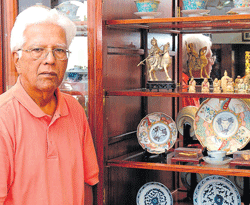K S Raman, a retired professor, has a passion for antique porcelain items. He has a collection of over 100 items from various countries and each piece is different from the other.
Things made out of Imari, a well-known Japanese porcelain; Nanking Cargo, the blue and white porcelain made in Nanking and Nyonya; colourful porcelain items made in China, Malaysia and Singapore; Cloisonne, a brassware and Netsuke, a miniature Japanese sculpture, form part of his collection Porcelain boxes in various sizes and shapes with colourful and intricate designs, showpieces, pots, tea jars, flower vases, tea mugs, ‘Laughing Buddha’, plates, bowls, antique Chinese chairs and many such things decorate his house. A beautiful flower vase brought from Athens in 1963 was the first item he collected.
Raman had served as a professor at the National University of Singapore from 1984 and relocated to Bangalore when he retired in 2004. “When I was in Malaysia and Singapore, I had the opportunity to travel to China, Japan, US and Europe. It helped me develop a professional, business and personal relationship with the people there and study their culture. I was attracted by their beautifully furnished houses which had decorative pieces made out of porcelain. Impressed by this, I started collecting porcelain items from various countries,” he shares.
Raman says that he used to collect matchbox labels, cigarette packs, and movie notices when he was a high school student in the 1940s. “But, my collection of artistic objects started in 1963 when I spent a few days in Athens. A replica of an ancient Greek vase had caught my attention and I bought it immediately. I bought a replica of an ancient Egyptian vase in Cairo, which is now preserved in a relative’s house. Whenever I visit her house, she shows me the vase and taunts me saying, ‘I can return this to you, but at a hefty price’!’’ he laughs.
Most of the antique items are sourced from the night markets and small shops in Malaysia (from Kuala Lumpur, Malacca, Penang, Kunsan, Kota Bharu), Singapore, Hong Kong, and China (in and around Beijing). “Some of the larger pieces are purchased from reputed art and antique dealers. I bought the Imari bowls and plates from a certified antique dealer in a shopping arcade in Tokyo,” he informs. He says that these have aesthetic value.
When Raman began collecting these items, his family members were not that supportive. “Initially, my wife and children couldn’t understand why I was spending money on such things. As I continued doing so, they accepted it as one of my vices,” he smiles.
It was not easy for him to transfer his collection from Singapore to Bangalore. “We started bringing smaller objects in hand baggage during our several visits to Bangalore for vacation. We engaged a company to ship the whole collection to Bangalore. My wife Indira had taken extra care in packing each item with utmost care. Finally, we were able to transport everything without a scratch,” he informs proudly. As these objects do not require much care beyond occasional inspection and dusting, the couple doesn’t find maintenance a difficult task. “But, as both of us are old, it takes lot of time for cleaning. In the long run, we hope our son and daughter will look after these. Some others have also shown interest in certain items but we want to make sure that these items are kept safely,” he says.
source: http://www.DeccanHerald.com / Home> Supplements> Metrolife / by Rajani Hegde / DHNS / April 09th, 2012
